How Much Do Fashion And Beauty Brands Use Influencer Marketing
According to Wikipedia, "Influencer marketing (also influence marketing) is a form of marketing in which focus is placed on specific key individuals (or types of individual) rather than the target market as a whole." Over the last five years, it has grown from obscurity to a form of marketing where even the biggest brands understand its value. There have been numerous studies analyzing influencer marketing's effects, and experts sharing their wisdom on the topic. Here are 100 interesting facts, quotes, and statistics related to influencer marketing .
1. Influencer marketing is expected to grow to be worth $13.8 billion in 2021.
Despite initial concerns that influencer marketing might decrease thanks to COVID-19, it's actually increased. While some industries, particularly travel, have had to reconfigure their marketing, others have been able to adapt their marketing models to COVID-19.
From $1.7 billion in 2016, influencer marketing is estimated to have grown to have a market size of $9.7 billion in 2020. That's expected to reach $13.8 billion in 2021.
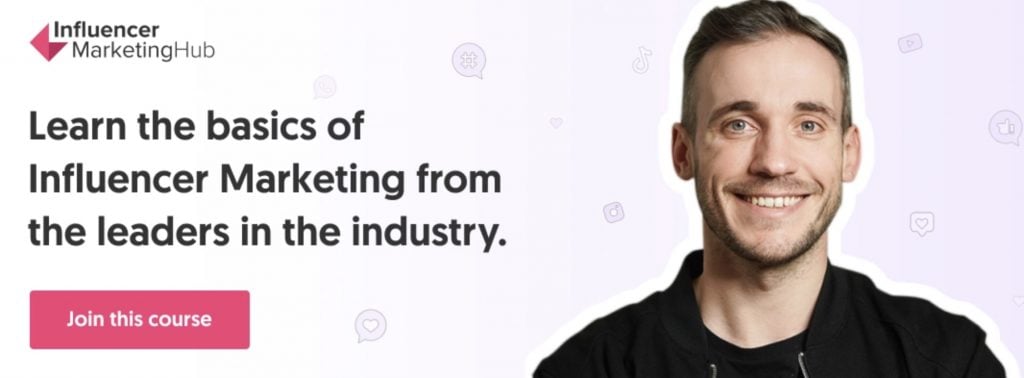
2. In 2019, 240 additional platforms and influencer marketing-focused agencies appeared on the scene.
As influencer marketing has grown and matured, more and more agencies are springing up to streamline and simplify the influencer marketing process for both brands and influencers. With the addition of 240 platforms in 2019, the total number of influencer agencies and platforms has reached 1360, nearly three times the number that existed just a couple of years ago.
3. The majority of brands (59%) have a standalone budget for content marketing, and 75% of them intend to dedicate a budget to influencer marketing in 2021.
Since our 2020 survey, the percentage of brands that have a separate budget for content marketing has increased by 4% to 59%. Given that HubSpot reports 70% of brands use content marketing, this number seems a bit low, though it's possible that the difference just means that some brands don't separate their marketing budget into different types of marketing.
4. 90% of our survey respondents believe influencer marketing to be an effective form of marketing.

Most brands that try influencer marketing seem to be happy with the outcomes. A staggering 90% of respondents to our influencer marketing survey indicated that they believe influencer marketing to be effective. This statistic has stayed pretty consistent over the years.
5. 56% of brands use the same influencers across different campaigns.
The majority of brands prefer to develop long-term relationships with influencers rather than finding another influencer every time they run a campaign. Larger brands will probably have a roster of influencers that they work with depending on the target market or products they're trying to promote, but that still doesn't change the fact that relationships are important to influencer marketing.
6. 36% of brands still tend to pay their influencers with free product samples (or even just discounts on more expensive products) rather than paying cash to their influencers.
A surprising 36% of respondents to our survey said that they pay influencers with product samples. And, 21% admitted to just giving discounts on products or services. Entries for giveaways were the preferred method of "payment" for 10.5% of respondents. This means that only 32.4% of brands pay influencers actual cash money for their work. It could be that these are smaller businesses working with micro and nano-influencers who are new to the game and just happy to be working. We're hoping that larger firms are paying influencers real money.
7. 67% of our respondents measure the ROI from their influencer campaigns.
A surprising 33% of firms don't measure their influencer marketing ROI. Of course, this means that two-thirds of them (67%) do. Measuring the ROI from your influencer marketing campaigns is just as important as it is for any other marketing campaign. If you're an influencer, make sure brands are measuring the ROI from your efforts so you can be sure to get the compensation you deserve.
8. 38.5% of brands view influencer marketing success based on conversions and sales.
Brands are increasingly focusing on using influencer marketing to generate real results that positively impact their bottom line. That's why 38.5% of brands believe that conversions and sales are the most important way to measure the success of their influencer marketing campaigns. Other brands measure success based on engagement or clicks (32.5%) and views, reach, impressions (29%).
9. 83% of firms take their influencer marketing spending from their marketing budget.

A majority of brands pay for influencer marketing from their marketing budgets, up just slightly from 2020. The remaining brands use public relations budgets to pay for influencer marketing, an indication that they're using influencers for brand awareness rather than to increase sales.
10. 67% of brands use Instagram for influencer marketing.
Instagram is the network of choice for influencer marketing campaigns with 68% of brands considering it the most important platform for them. While this is still a solid majority, it's down from 80% in 2020.
11. The percentage of brands using TikTok for influencer marketing continues to increase.
Despite being lumped into the Other category last year, TikTok now comes in second place for the most important social media platforms for influencer marketing. This year, 45% of survey respondents indicated they're using TikTok for influencer marketing.
12. Brands still use other social media platforms for influencer marketing.
While Instagram and TikTok are the big ones, brands are still consistently using other social media platforms for influencer marketing. Facebook use has decreased by 3% to 43%, YouTube stayed steady at 36%, Twitter use dropped by 7% to 15% this year, and LinkedIn stayed the same at 16%. Like TikTok, Twitch also broke out of the Other category this year with 8% of brands reporting a penchant for influencer marketing on the platform.
13. 67% of brands are concerned about influencer fraud.
We've all heard the horror stories of influencer fraud. Fortunately, there are tons of tools that can help detect fraudulent influencer activity and reduce the effects of influencer fraud.
14. Only 38% of brands claim to have experienced influencer fraud (down from 68% last year).

While brands are still worried about influencer fraud, the percentage of brands reporting that they've experienced influencer fraud fell dramatically from 68% last year to just 38% this year. With the number of fraud detection tools out there, it's not surprising that fewer brands are reporting influencer fraud.
15. 67% of respondents prefer their influencer marketing to be campaign-based rather than always-on.
While brands prefer to build long-term relationships with influencers, they still think of influencer marketing in terms of campaigns instead of an ongoing thing. This means that once a campaign is completed, a new one will be planned, organized, and schedules.
16. 34% of brands that run campaigns in-house say that finding influencers is the most significant challenge for them.
This percentage is down from 39% last year which is probably due to the proliferation of influencer marketing platforms. Brands also indicated problems with measuring ROI and campaign results (23.5%), managing contracts and deadlines for campaigns (13%, down from last year's 21%), processing payments to influencers (10%), and bandwidth or time restraints (9.5%, down from 16% last year).
17. Micro-influencers have better engagement rates than mega-influencers.
Micro-influencers on Instagram boast an average engagement rate of 3.86%. This declines for every level of influencer before hitting 1.21% for mega-influencers. Plus, while YouTube engagement rates tend to be low all around, micro-influencers get an average engagement rate of 1.64% compared to the 0.37% rate of mega-influencers. For TikTok, this difference is most notable with micro-influencers on the platform getting engagement rates of nearly 18% while mega-influencers get just under 5%.
18. Influencer marketing campaigns increased throughout 2020.
Upfluence reports that COVID-19 did have an initial impact on the number of influencer marketing campaigns for the first two quarters of 2020. However, the number of campaigns increased dramatically for Q3 and Q4. After reaching 2,110 campaigns in Q4 of 2019, influencer marketing campaigns dropped to 1,945 in Q1 2020 and then dropped again to 1,575 in Q2. In Q3 of 2020, though, influencer campaigns increased to 2,163 and jumped even more in Q4 to 2,901.
19. 80% of brands say they've increased the amount of content they produce.

In 2020, 80% of brands reported an increase in content output over the past two years. While this is down from last years' 84%, the cumulative effect is an increase in content.
20. 50.7% of brands working with influencers run eCommerce stores.
The respondents to our influencer marketing survey come from different business backgrounds and include brands, marketing agencies, PR agencies, and others, so it was surprising to find that slightly more than half of the respondents were involved in eCommerce. This could indicate an increase in eCommerce popularity for all types of business.
21. Businesses are making $5.20 for every $1 spent on influencer marketing
A 2019 survey by The Influencer Marketing Hub (partnered with Viral Nation and NeoReach) emphasizes how influencer marketing can be highly lucrative for those brands who engage in it. The top 13% of businesses make $20 or more. Most companies get positive results from influencer marketing, with just the bottom 25% failing to generate any revenue. These are often firms that don't understand the mechanics of influencer marketing. Some businesses simply select the wrong influencers for their brand. They fail to choose influencers who have followers similar to the people who make up the target market for the brand's product.

22. 63% of marketers intend to increase their influencer marketing budget in the next year.
This statistic comes from the same Influencer Marketing Hub survey. Marketers clearly see how lucrative influencer marketing can be to a brand - when it's done correctly.
Nearly 2/3 (63%) of businesses who do budget for influencer marketing intend to increase their spending over the next 12 months, with 17% expecting their influencer marketing spend to remain the same.
23. Successful YouTubers can earn millions from their videos
Wondershare has researched to find the richest YouTubers in 2019. They found the richest YouTubers (with their estimated earnings) to be:
- Daniel Middleton (DanTDM) - $16.5 million
- Evan Fong (Vanoss Gaming) - $15.5 million
- Dude Perfect - $14 million
- Mark Edward Fischbach (Markplier) - $12.5 million
- Logan Paul - $12.5 million
- Felix Kjellberg (PewDiePie) – 12.5 million
24. Quote: "...when working with influencers, brands have to let go and allow influencers control of the narrative to preserve the authenticity of what is being communicated."
Priyanka Dayal, content marketing manager at Centaur Media PLC, observes how influencer marketing is different from traditional marketing, where brands have traditionally had full control over their marketing. She emphasizes the fact that today's consumer can tell the difference between an advert, a personal recommendation, and an advert masked under a personal recommendation. "For influencer marketing to sustain, authenticity and credibility is key."
25. Department store chains now partner with fashion bloggers to promote new initiatives and publicize their stores
Quite a few of the big name department stores recognize the influence of fashion bloggers in promoting their stores and products. These include Bergdorf Goodman, Harrods and Bloomingdale's. These partnerships allow the fashion stores to connect with consumers on a more intimate level than traditional celebrity endorsement.
26. 61% of marketers consider finding relevant influencers for a campaign difficult
Mediakix carried out its annual Influencer Marketing Survey in 2019. Of the marketers they surveyed, 61% acknowledged the difficulty in finding relevant influencers for a campaign. If you don't partner with the right influencers for your product, the campaign is doomed to fail from the start.
27. 69.4% of influencers chose to be influencers so they could earn revenue
Tapinfluence and Altimeter joined forces to produce a study on the state of influencer marketing , interviewing influencers. When asked to provide reasons for their participation in this form of marketing, nearly 70% admitted that their main inspiration was to earn some money. 57.5% of them also claimed that they engaged as influencers to make an impact or effect change
28. Quote: "Engagement is the new impressions. It matters as much, if not more, than someone's reach."
Kristy Sammis made this comment in a March 2016 episode of the podcast, Half Hour Intern. She made another very salient point: "We're savvier than ever, and we know B.S. when we smell it...As soon as you try to interrupt their (the influencer's) voice and shove your corporate words into their mouths, there is no purpose in working with them."
29. The aim of Influencer Marketing is to identify the influencers in your niche and make them work for you by promoting your brand.
A firm's emphasis needs to be on reaching to the people from whom they can get maximum conversions rather than targeting the market as a whole.
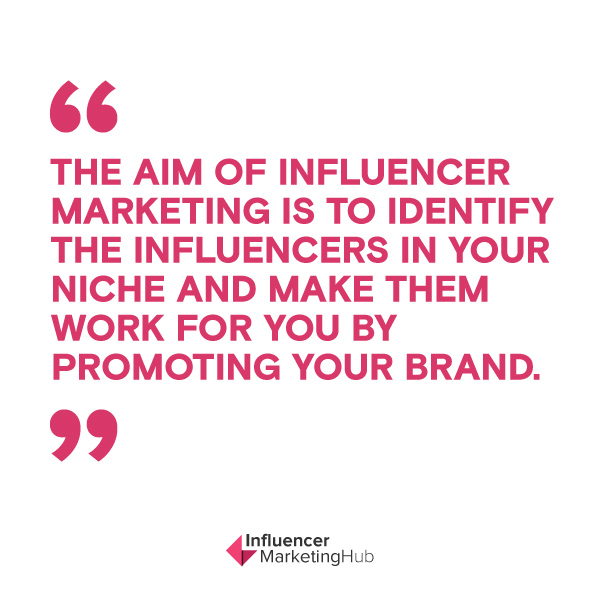
30. 54 percent of influencers say they will work with brands who respect them as they would any other publisher
Crowdtap interviewed more than 50 content creators, and it is clear that these influencers expect respect from brands who work with them. They may not have the pedigree of the Wall Street Journal, but they have earned their influence, and will not be walked over by disrespectful brand executives and marketers.
31. Content creators say their most important method for vetting brand partnerships is by determining which opportunities are most relevant for their audiences
This is from the same Crowdtap survey as above. Brands must remember that while influencers like to be able to earn revenue, they will not do so at the expense of their audience.
32. 67% of marketing and communications professionals engage with influencers for content promotion
A May 2015 study by Schlesinger Associates for Augure showed that content promotion was the main reason that marketing and communications professional engaged with influencers - ahead of product launch, content creation, event management, corporate communications, SEO, and crisis management.
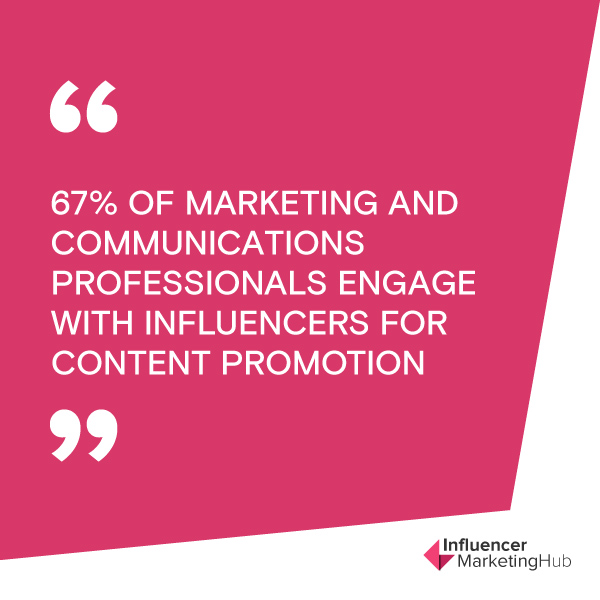
33. 75% of marketing and communications professionals say verified web traffic of an influencer is the most important criteria when selecting an influencer
This is an interesting statistic from the same Schlesinger Associates for Augure survey as above. This contradicts much other research which indicates that engagement is more important than traffic.
34. The increase in influencer marketing 2014-2019 mirrors the decrease in print advertising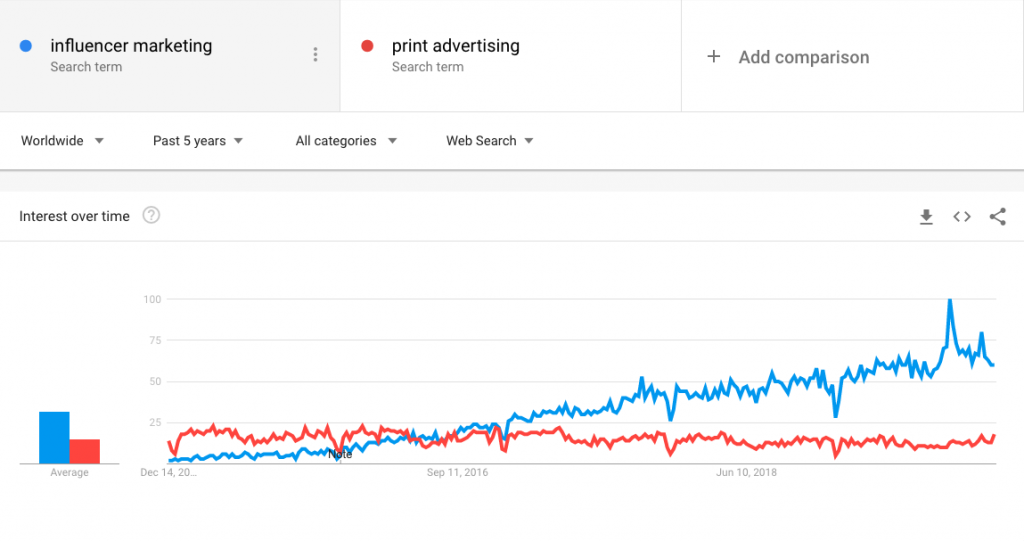
Google Trends shows a comparable rise in influencer marketing at the same time as print advertising has been falling. Searches for "influencer marketing" drew ahead of those for "print advertising" in mid-2017 and have remained that way ever since.
35. There are five types of influencers: Celebrity (Mega) Influencers, Macro Influencers, Mid-Tier Influencers, Micro-Influencers, and Nano-Influencers
Influencer marketing does not focus on celebrity endorsement. Micro-influencers perform the bulk of successful influencer marketing (at least 90% of it). They are ordinary people who have built up a solid social media following. While there are no strict definitions of follower numbers, a general guide to the types is:
- Mega-influencers – social superstars with more than a million followers. These are often celebrities
- Macro-influencers – influencers with between 100,000 and 1 million followers
- Micro-influencers - someone who has between 1,000 and 100,000 followers. While their following may be small(ish), their authenticity is high
- Nano-influencers – somebody with fewer than 1,000 followers who has immense influence with a comparatively narrow niche.
36. Instagram is the Most Important Channel for Influencer Marketing by Far
Our 2019 State of Influencer Marketing survey reiterated results from an earlier Bloglovin' survey. Instagram has grown rapidly to become the social channel of choice for influencer marketing. 79% of our survey respondents consider Instagram important for their influencer marketing campaigns. Facebook came a distant second at 46%, followed by YouTube at 36%.
It is important to remember, however, that this all depends on your target audience. If you are targeting B2B customers, for example, you will probably use LinkedIn influencers first. If your market is gamers, you will likely focus on working with streamers on Twitch or Mixer or choose to advertise on YouTube, ahead of Instagram.
37. 77% of fashion micro-influencers prefer Instagram

Instagram engagement rate. Source Locowise
The influencers preference for Instagram grows even greater when the influencer works in a highly visual niche such as fashion. In comparison, only 31% of entertainment/pop culture micro-influencers prefer Instagram - a less visual niche.
38. 53% of micro-influencers have never paid to promote a post.
This result comes from a Bloglovin' survey on How Micro-Influencers Really Want to Work With Brands . The majority of influencers have managed to achieve their influential status without paying for promotion. Less than 10% have paid for Instagram native ads, despite their love of this platform. Of course, brands can gain extra reach should they choose to pay for boosted/promoted posts.
39. Quote: "As long as I get to do my thing and someone wants to write me a check for it, I'm all about it." – Mike Perry, Broad City Designer
If you, as a brand, have done your homework, you should have selected the most suitable person as your influencer. Remember that they have built up their own brand. Therefore you need to ensure that your messages to their audience are authentic to that audience. You need to encourage your influencers to share your brand story in their voice.
40. Nearly 40% of Twitter users say they've made a purchase as a direct result of a Tweet from an influencer
Twitter partnered with @Annalect to study people's receptivity to influencers on Twitter. It is clear that Twitter influencers have built up a sufficiently high level of trust for people to be confident enough to spend money on their recommendations.
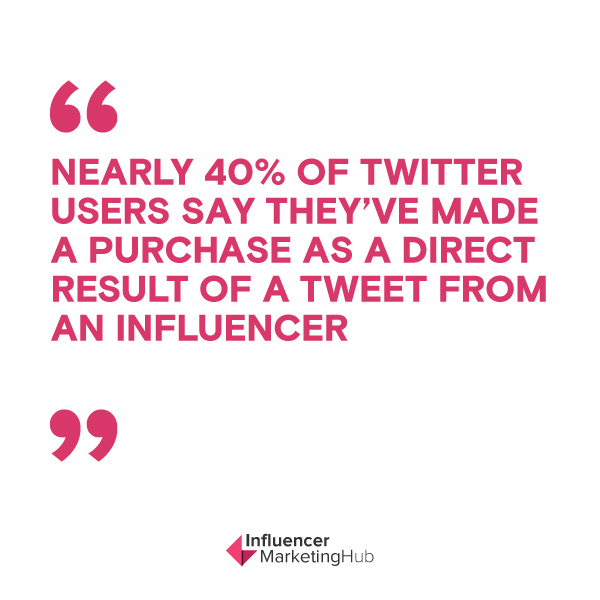
41. Participants aged 13-24 were twice as likely to evaluate an influencer by their social presence and follower count as older audiences
This was another result from the Twitter survey. There is a clear distinction in the way that different age groups look at influence in social media. Older generations tend to follow traditional celebrities. Millennials and Generation Z are more likely to take an interest in social media sensations, such as PewDiePie.
42. 70% of teenage YouTube subscribers say they relate to YouTube creators more than traditional celebrities
This statistic, provided by Google, again emphasizes the differences between the generations. Television has a far smaller impact on Generation Z that is had on previous generations. Hence they have far less of interest in traditional celebrities. The current generation has grown up with the internet, and the internet is where they find their own celebrities.
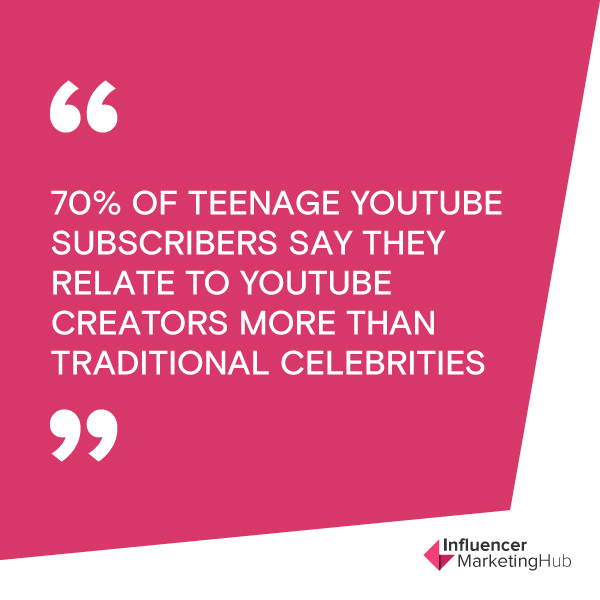
43. 6 in 10 YouTube subscribers would follow advice on what to buy from their favorite creator over their favorite TV or movie personality
This is another sobering statistic from Google that emphasizes the differences between the generations. If marketers do not recognize these marked differences, they do so at their peril.
44. Firms still find it difficult to determine the Return on Investment on an Influencer Marketing Campaign
As influencer marketing has become more widespread, there have been quite a few studies on how to best determine an ROI from a campaign. The reality is that the ROI is very much determined by the brand's intention. Traditional marketers and executives still struggle with this open-ended concept.
45. Quote: "It's really hard to measure true influence."
Duane Forrester, VP of Organic Search Operations at Bruce Clay, emphasizes how difficult it is to come up with the definitive measure of influence. He does, however, recognize that although this metric may be difficult to measure it is still nonetheless exceedingly important.
46. When looking for influencers, it is important to engage people who already have an affinity for your brands.
If people already love your products, they will speak about them with passion and knowledge, and this will, in turn, inspire others
47. 91% of millennials trust online reviews as much as friends and family
This is a finding from the BrightLocal Local Consumer Review Survey 2018 . It does emphasize the high level of influence that influencers can have on their audience. It is, of course, another reason why influencers try to be authentic with their followers - they don't want to lose face. Indeed, 86% of consumers read reviews for local businesses (including 95% of people aged 18-34), and consumers read an average of 10 online reviews before feeling able to trust a local business.
48. 50% of consumers will take some action after reading a positive review
This is further a result of the BrightLocal survey indicating why firms need to work on ensuring that they receive positive online reviews for their products. Interestingly, older people are more likely than younger to go to a company's website after a good review (35 of 18-34 year-olds, 47% of 35-54 year-olds, 69% of 55+).
Other common reactions to reading a good review include searching for more reviews to validate choices (19%), visiting the business location (15%), contacting the business (13%), and continuing to search for other businesses (10%).
49. 210 million people use Snapchat daily, making it a highly viable influencer marketing channel
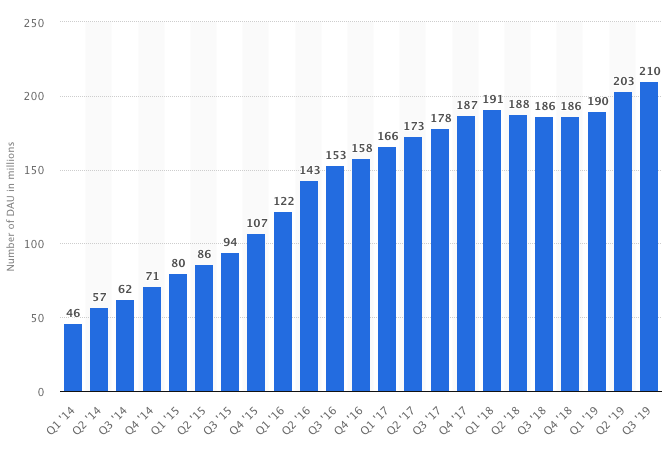
Daily active users on Snapchat. Source: Statista
Snapchat has quickly grown to 210 million users , and it is particularly popular with teenagers. Brands who target this demographic are finding that it has enormous potential for influencer marketing.
50. The best influencer marketing campaigns are very organic and do not look like advertising.
They seem to work best when brands engage influencers to tell a story on behalf of the brands in intuitive ways.
51. 45% of North Americans use Ad Blockers
Although the use of ad blockers rose quickly for a while, their use has been relatively static over the last two years, according to GlobalWebIndex . 46% of North Americans used them in 2017, but this fell slightly to 45% in 2018. 40% of Europeans used ad blockers in each year. People in APAC countries use them more – 52% in 2017, down to 50% in 2018.
52. More than half of 18–24s have their first contact with social media each day on smartphones.
According to the Reuters 2018 Digital News Report, 57% of 18-24-year-old Americans make their first daily contact with news on their smartphones via social media. This statistic changes as people age, with only 29% of people aged 35% first encountering news via social (their main means is going direct to news sites).

53. Quote: "Social media allows big companies to act small again."
Jay Baer has regular social media speaking engagements. This is one of his regular one-liners he likes to use regularly - and it is of course very true when it comes to influencer marketing.
54. Quote: "Social media changes the relationship between companies and customers from master and servant, to peer to peer."
Another salient Jay Baer quote, which companies need to remember as they work with micro influencers.
55. Influence can be fickle. It can change almost overnight.
The list of influential people on social media is constantly changing. Today's influencer may be tomorrow's has-been. It is important that brands keep up-to-date with who the current influencers are. Even Pewdiepie will seem old one day.
56. Some brands are influencers already
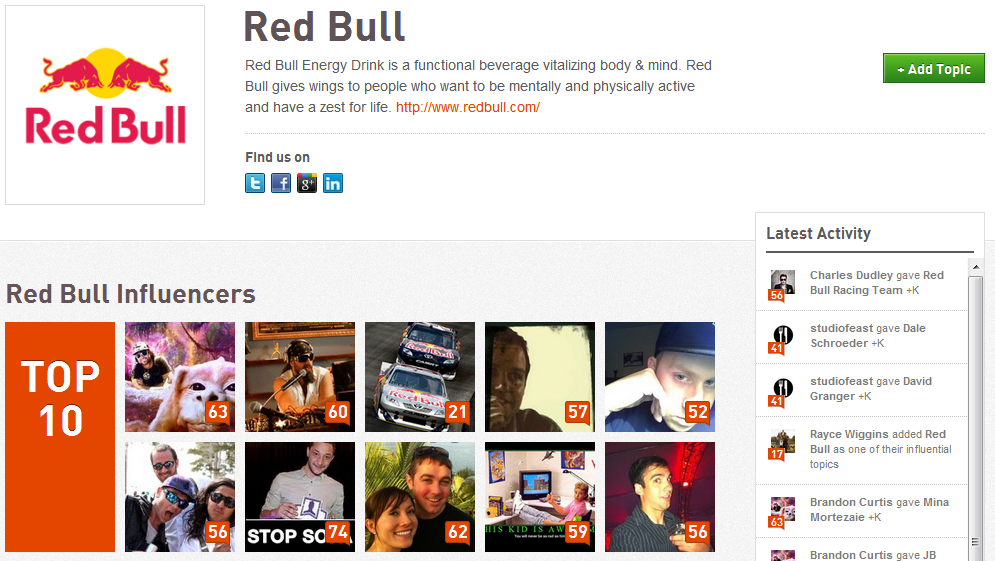
Top Red Bull influencers on Klout
Some brands have established sufficient online clout that they can be considered influencers themselves. Red Bull, for instance, has established a very active YouTube presence and currently has 5.6 million subscribers to their main channel and they have numerous smaller specialist channels, too.
57. 68% of bloggers prefer to work directly with a brand instead of an agency or network
4,000 were surveyed by Grouphigh. One thing that came through is that although more agencies pitched bloggers than brands did, bloggers preferred to work directly with brands.
58. The Average Click Thru Rate for Banners is 0.06%
Too many brands blindly buy banner ads in the hope that people will click through to their landing pages. The problem is that click-thru rates are abysmal, 0.06%, according to Google . Yet, banner ad growth in 2017 was 7%. Even more embarrassing, 60% of clicks on banner ads are reportedly accidental, and 90% of ad clicks are by bots.
59. Quote: " People want to do business with you because you help them get what they want. They don't do business with you to help you get what you want."
Don Crowther reminds businesses of the real reason that firms receive customers. Even influencers won't help your sales if you can't provide what consumers truly want.
60. Quote: "Influencers are people with significant networks (followers, readers, etc.) who can speak to a broad range of products and services with the ability to sway opinions in their favor."
Digital strategist, blogger, and influencer, Jess Estrada, gives her opinion on what makes an influencer
61. Friends influence 81% of consumers' purchasing decisions on social media
According to a study reported by Vivipins , the vast majority of people (81%) let their friends and family on social media influence their purchasing decisions. Peer pressure still clearly plays a significant role.
62. Quote: "Influencers think that because they have some audience, they have the power. And of course they have some power, but they should be careful in how they use it."
Tim Bax of iCrossing issuing a warning to those influencers who risk alienating the brands who pay them.
63. Lord & Taylor Got 50 Instagrammers to Wear the Same Dress, Which Promptly Sold Out
Retailer Lord & Taylor partnered with 50 influential fashionistas on Instagram and had each pose wearing the same dress. The dress sold out by the end of the weekend, and it gave the brand a chance to introduce their Design Lab Collection to potential customers, who followed these influencers.
64. 84% of companies plan on working with a social media star in the next year
This was according to a survey conducted by Augure and reported in Mediakix. Collaborating with a digital influencer is now one of the most trusted and effective ways for brands to reach consumers.
65. Instagram has more than 1 billion monthly active users
Although Instagram has been slow to release user numbers recently, it first exceeded 1 billion monthly active users in June 2018, with more than 500 million of them using the platform daily. While there are fewer Instagrammers than people using big brother Facebook, Instagram is now the preferred platform of the young. It is also rapidly becoming the most popular influencer marketing platform.

66. As an Instagram influencer's follower total rises, the rate of engagement (likes and comments) with followers decreases
This is the key finding from a survey carried out by Markerley. Those with less than 1,000 followers generally received likes on their posts 8% of the time. Users with 10 million+ followers only received likes 1.6% of the time.
67. Influencers in the 10k-100k follower range offer the best combination of engagement and broad reach
As a result of their research, Markerly believes that influencers in the 10k-100k follower range are the micro influencers that brands should focus their influencer marketing on - not celebrities with huge followings but low engagement.
68. Quote: "Our research shows that real life influencers who are passionate about what they are recommending have significantly more buying conversations, and consumers are more likely to act on their recommendations."
Brad Fay, co-founder, COO and lead researcher of the Keller Fay Group, commenting on research that his group carried out on the scope of micro-influencers.
69. Micro-influencers have 22.2 times more conversations weekly about recommendations on what to buy when compared to an average consumer
This was a key result that came out of the above research carried out by The Keller Fay Group and Expercity.
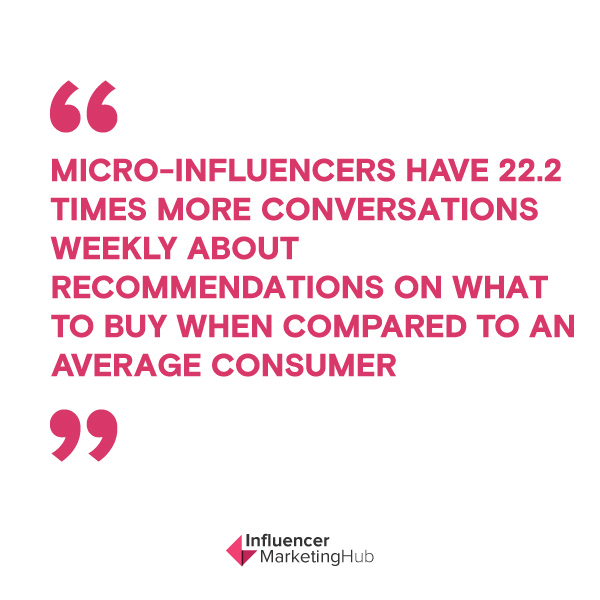
70. 4 in 10 Snapchatters claim that they discover brands thanks to Snapchat celebrity endorsements and online posts
Snapchat users have shown that they are highly responsive to influencer marketing. 39% of Snapchat users say they discover brands via celebrity endorsements, online posts from expert bloggers, or through vlogs.
71. 89% of people surveyed say ROI from influencer marketing is comparable to or better than other marketing channels
In MediaKix's 2019 Influencer Marketing Survey, 48% of the respondents believed that the ROI from influencer marketing is better than other marketing channels. A further 41% say returns are equal to other sources.
72. Software reviews influence 98% of buyers
Capterra found that software reviews can be pivotal to businesses buying software. Online reviews are as important for B2B marketing than B2C – in some cases, more so. Their research found that reading reviews was the most important factor for 18% of software buyers. It was a big influence in a further 48% of purchases. A further 20% claimed that software reviews had somewhat of an influence, and 13% admitted it had a little influence. This means that a mere 2% of software buyers make no use of software reviews for their purchasing decisions.
73. 71% of Instagram users are under the age of 35
Recent data from Statista emphasizes just how young Instagram's userbase is. 6% of their worldwide users are aged between 13 and 17, 30% are 18-24, and 35% come in the 25-34% age range. Numbers drop down to 16.3% of 35-44 year-olds, with even fewer Instagrammers in the older age brackets.
74. 17% of companies budgeting for influencer marketing in 2019 were preparing to spend $500,000 or more
Mediakix found some interesting results when they asked people in their survey how much they intended to spend on influencer marketing in 2019. 7% intended to spend over $1 million, with a further 10% between $500,000 and $1,000,000. A mere 15% were simply going to test the waters with a budget of between $0 and $1,000.
75. Influencer Marketing ROI blows online advertising out of the water. However, using influencers to solely drive awareness is as cost-effective as a Paula Deen fitness camp. The key to effective use of influencers is their ability to cause behavior
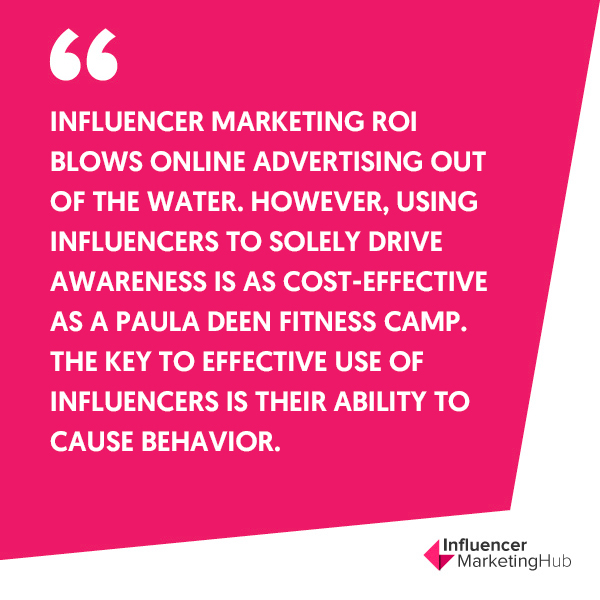
Jay Baer – the NY Times bestselling author on the importance of selecting the right influencers.
76. YouTube has 2 billion users worldwide
YouTube has recently emulated Facebook's feat of reaching 2 billion active users. Its popularity is increasing across nearly all age groups. Not only do the young use it as a television replacement, but the older generations cherry-pick videos on topics that interest them, too. While most of the other social networks now cater to video, YouTube is still seen as the preeminent site for longer videos. This makes it ideal for brands wanting to showcase a product's benefits and features, or a place for in-depth video reviews.
77. 320 new influencer marketing platforms and agencies set up shop in 2018
As influencer marketing has grown in popularity, so have the platforms and agencies that act as support facilities. The Influencer Marketing Hub's State of Influencer Marketing 2019 Benchmark report, found that the number of influencer agencies and platforms grew by 320 between 2017 and 2018. Back in 2015, there were just 190 influencer platforms and agencies. This grew to 335 in 2016, 420 in 2017, and 740 in 2018 – more than twice the number that existed just two years previously.
78. Instagram Stories has become pivotal to influencer marketing success
Instagram Stories has become the greatest success story of the Instagram family. Instagram introduced them in 2016, and by January 2017, there were 150 million daily Instagram Stories users. Numbers have continued to rise, surpassing the 500 million mark in January 2019.
79. 17% of marketers expect to spend over half their budget on influencer marketing
Mediakix asked marketers how much of their budget they intended to spend on influencer marketing. While most firms only intended to include it as a small component in their marketing mix, 17% expected to devote half or more of their marketing budget to influencer marketing. Indeed, 6% planned to spend more than 90% of their marketing budget on influencer marketing.
80. A large percentage of younger audience's time is spent watching video
When Vidmob carried out their 2018 State of Social Video (US edition) survey they 33% of millennials spent 33% of their digital time watching video. The younger Generation Z are even more into the medium, and they spend 41% of their video time watching video, versus articles or photos.
81. Generation Z and Millennials significantly increased their time on social media in 2018
Vidmob found that 42% of Generation Z and Millenials spent more time on social media this year (2018) than the previous year. The growth in usage of social apps is 40% higher than mobile browsers.
82. Creating remarkable content is the first step to an effective strategy, but if nobody actually interacts with your content, it's a lost effort. Finding the key influencers that will amplify content is the next step. This is where content marketing and influencer marketing become best friends in modern marketing 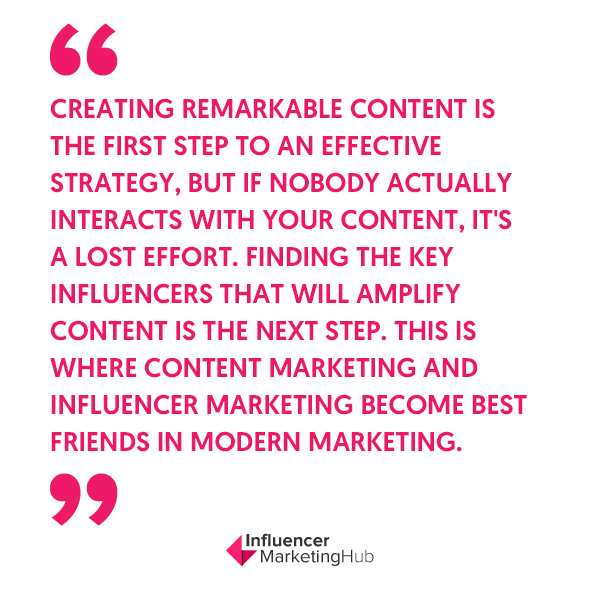
Arthur Hilhorst, digital marketing lead at Onalytica, a London tech startup, in Why Influencers are Essential to Content Marketing Success .
83. YouTube is the world's second most visited website; Facebook is the fifth
According to Alexa , YouTube is the second most visited website after just Google. Facebook moves around in the rankings, but it is currently in 5 th place. With Google owning YouTube, the company can clearly claim web dominance.
84. Facebook was the most searched term in Google during Q3 2019
Hootsuite has collated many digital-related statistics in its Global State of Digital in 2019 Report . It has issued updates every quarter. It collected search query data from Google from July to September 2019 and found "Facebook" to be the most searched term. "YouTube" was third and "Instagram" tenth.
85. There are 3.725 billion active social media users globally
Another statistic unearthed in Hootsuite's report is that there were 3.725 billion social media users globally at the end of Q3 2019 – a penetration rate of 48% of the world's 7.734 billion population. This was an increase of 328 million social media users – a 9.6% increase. The world's population rose by 1% in the same period.
86. There are 3.660 billion active mobile social media users globally
The Hootsuite report emphasizes the importance of mobile nowadays. The vast majority of the people who use social media worldwide do so with mobile devices at times. This statistic grew by 15% over the last year. Notably, there are now 5.155 billion unique mobile users, making mobile phones truly part of our everyday life.
87. Despite the massive uptake in mobile use, laptops and computers still have an essential role in internet usage
With such a high number of mobile social media users, you might be forgiven for thinking that the days of laptops and computers may be over. Yet Hootsuite found that mobile phones still only account for 51.74% of web traffic, with laptops and computers still accounting for 44.53%. Tablets, 3.65%, and Other Devices (such as gaming systems), 0.08%, make the difference. Notably, the use of laptops and computers on the internet grew 1.0% in relative terms this year, while mobile phones only grew by 0.2%. Tablets and Other Devices were the big losers, dropping by 13%, and 20%, respectively.
88. 75% of online users have purchased a product or service online in the past month
Hootsuite also reported how common it now is for people to shop online, 75% have recently purchased a product or service online, using any device. 82% have searched online for a product or service to buy, suggesting that some must search online and then complete their purchase in a brick and mortar store.
89. Twitch continues to grow in popularity despite the defection of a few famous names
Despite the defections of Ninja and Shroud to rival Mixer, Twitch is still increasing in popularity as a live-streaming platform. TwitchTracker shows clear upward-sloping trends for the site. There were 3.2 million streamers in November 2019, who people collectively watched for 880 million hours. There was an average of 1.2 million concurrent viewers at any time. Sunday is the most popular viewing day, although more people broadcast on Saturdays on average.
90. The FTC sent letters to 21 influencers
In recent years, the FTC has taken an interest in influencer marketing, where influencers have failed to disclose that they received payment for their posts. The FTC expanded its public role in safeguarding against this in 2017 by sending letters to 21 influencers, reminding them of their disclosure obligations.
91. I don't play with female gamers.
This quote by Tyler "Ninja" Blevins shows how important it is that you research potential influencers before you decide to work with them. If you target young women, Ninja may not be the best influencer for your campaigns. Being married, Ninja is mindful of upsetting his wife. "If I have one conversation with one female streamer where we're playing with one another, and even if there's a hint of flirting, that is going to be taken and going to be put on every single video and be clickbait forever."
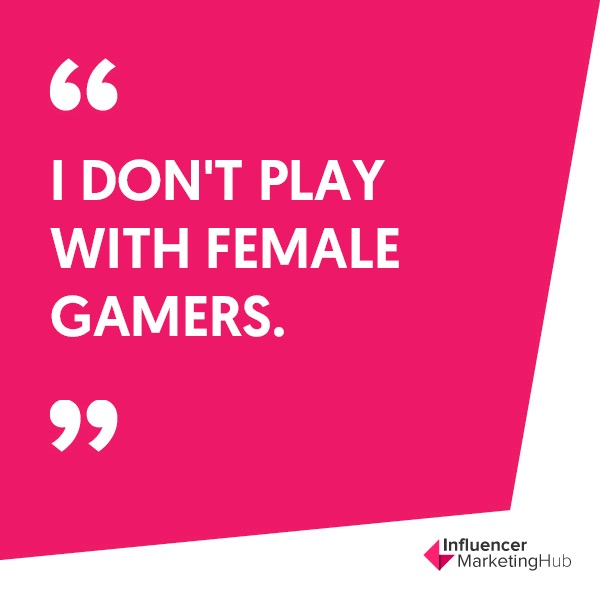
92. Facebook expects to rely on Instagram for the majority of its ad revenue growth
Instagram's ad revenue is growing at a faster rate than Facebook's. Some pundits expect that Facebook will eventually rely on Instagram for the majority of the company's advertising revenue growth. Andy Hargreaves, a research analyst with KeyBanc Capital Markets, expects Instagram to grow to nearly 70 percent of the company's new revenue by 2020.
93. Roughly ¾ of Facebook users visit the site daily
While Facebook users may not be the most targeted audience by influencer marketers, they still use the social site regularly. Pew Research has found that 51% of Facebook users use the app/site several times a day, with a further 23% using Facebook about once a day. This compares with Instagram (42% multiple times daily, 21% daily) and Snapchat (46% numerous times daily, and 15% daily). YouTube and Twitter users visit the sites on a less regular basis.
94. 83% of people earning over $75,000 pa use YouTube and 74% use Facebook
The Pew Research data looked at key demographics for all of the major social networks. It showed a higher percentage of wealthy people using most social networks than people on low (or medium-level) incomes. The sole exception was Snapchat, where the highest percentage (27%) were those earning less than $30,000. This is probably because many Snapchat users still attend school.
95. Considerably more rich people use Pinterest than poor people
While the percentage of people using Pinterest is lower than for more mainstream sites, such as YouTube, Facebook, and Instagram, there is much more variation in income levels. Brands in the home decor niche will be particularly interested to note that although only 18% of those with incomes less than $30,000 use Pinterest, this number grows dramatically to 42% for people who earn more than $75,000. Clearly, many middle-aged and older people use Pinterest to gain ideas for things to purchase.
96. LinkedIn features 90 million senior-level influencers
LinkedIn has released a diagram highlighting some of the key demographics of its members . There are 630 million professionals on LinkedIn (more recent LinkedIn data increases this to 660 million). These include 90 million senior-level influencers, 40 million mass affluent, 63 million decision-makers, 17 million opinion leaders, 10 million C-level execs, 6 million IT decision-makers, and 3 million MBA graduates.
97. LinkedIn is highly important for sharing professional content
Although many people think of LinkedIn as a large-scale collection of resumes and a job market, it is also a place where professionals publish and share content. Many firms in the B2B sector market on LinkedIn. According to LinkedIn, they have had 9 billion content impressions, with 15 times more content impressions than job postings. 57% of the content impressions come from mobile.
98. Higher Education is the industry with the highest engagement on Instagram
RivalIQ's 2019 Social Media Industry Benchmark Report offers some interesting statistics on social engagement. Those in the higher education niche manage 3.96% engagement on their Instagram posts. The medium across all industries is 1.60%. Surprisingly, considering how popular Instagram beauty influencers and brands are, the engagement rate for health and beauty posts is only 0.86%.
99. Fashion brands see their highest engagement rates on Instagram, but they are still below average
As popular as fashion is on social media, it has surprisingly low engagement on all leading social platforms, according to the RivalIQ stats. Fashion brands receive 0.94% engagement on Instagram, 0.04% on Facebook, and 0.033% on Twitter.
100. How-tos, tutorials, and hacks are the most popular types of videos watched on YouTube
The Vidmob analysis shows that Millenials and Generation Z clearly use YouTube to learn, rather than just for entertainment. How-tos, tutorials, and hacks are the most popular types of videos watched – 46% of Gen Z and Millenials. Vlogs draw 42% of Gen Z, followed by Pranks (37%) and, a distant third, Unboxing (27%).
Frequently Asked Questions
Is influencer marketing effective?
Influencer marketing continues to be an effective method of marketing. Most brands that try influencer marketing seem to be happy with the outcomes. A staggering 90% of respondents to our influencer marketing survey indicated that they believe influencer marketing to be effective. This statistic has stayed pretty consistent over the years.
Is influencer marketing a big industry?
Influencer marketing continues to grow into a massive industry. From $1.7 billion in 2016, influencer marketing is estimated to have grown to have a market size of $9.7 billion in 2020. That's expected to reach $13.8 billion in 2021. While some industries, particularly travel, have had to reconfigure their marketing, others have been able to adapt their marketing models to COVID-19.
Why is influencer marketing so valuable?
Influencer marketing offers visibility and increased audience reach with different audiences, in a way that isn't possible to achieve in other ways. With the right strategy and management, influencer campaigns can give your brands a boost in potential customer attention and growing digital marketing ROI.
How many influencers are there in 2020?
Instagram influencers are growing by the day. Statistics show that there are more than half a million influencers on Instagram alone. As influencer marketing has grown and matured, more and more agencies are springing up to streamline and simplify the influencer marketing process for both brands and influencers. With the addition of 240 platforms in 2019, the total number of influencer agencies and platforms has reached 1360, nearly three times the number that existed just a couple of years ago.
How many followers make you an influencer?
Influencers can have a big range of followers. Micro-influencers have around 100,000 followers, though micro-influencers many times have less than 100,000 followers, though they have a strong specialty in a certain niche. They also normally have big interactions with their followers. Bigger-time influencers can have hundreds of thousands of followers, if not more.
How Much Do Fashion And Beauty Brands Use Influencer Marketing
Source: https://influencermarketinghub.com/influencer-marketing-statistics/
Posted by: morganjonster.blogspot.com

0 Response to "How Much Do Fashion And Beauty Brands Use Influencer Marketing"
Post a Comment